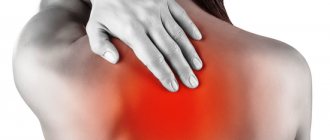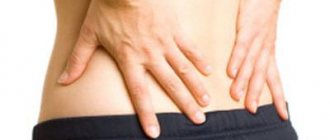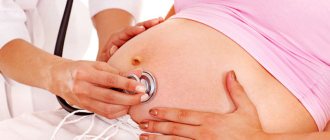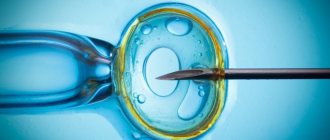Either the ligaments or the muscles between the legs hurt. Like after exercise. When I touch it, it’s not the bones that hurt, but the muscles. Is the pelvis already slowly moving apart? Or something different? It hurts since 11 weeks. At night sometimes I can’t roll over because it hurts so much. In the evening the pain intensifies
In my first pregnancy, this started after 30 weeks, I couldn’t walk, I was already crying. And now from 20. The gynecologist prescribed calcium D3 and magnesium, to drink until 32 weeks in addition to vitamins (I drink Elevit). Therefore, tell your doctor, maybe he will prescribe you to drink extra.
Swelling of the legs
When a woman's body carries an unborn child, sudden changes in hormonal levels occur. The hormone relaxin, characteristic of pregnant women, increases the elasticity of connective tissues. Every day a woman’s weight increases, and the strength of the tissue decreases. Also, the body retains fluid, which is necessary for the life of the fetus. Its excess remains in the lower part of the body. The fetus puts pressure on the vessels (in particular, the veins), as a result of the weakening of the connective tissues, the pressure in them drops, it is not enough to push the blood flow upward, because of this, swelling often occurs. They may be accompanied by unpleasant sensations, even pain in the lower extremities.
To prevent the elimination of pain due to swelling, you need to do special physical exercises, for example, try to raise your legs while lying on your back, at least 20 centimeters upward. Or while sitting, on occasion, do circular rotations, first with one leg, then with the other. Under no circumstances should you give up fluids, as this can harm the fetus.
Why does pain occur?
This largely depends on how far into the pregnancy you are. If the perineum hurts during pregnancy, a woman should consult a gynecologist. The causes of this syndrome can be very different.
Pain in the early stages
The perineum hurts during early pregnancy, most often due to some pathology. After all, the fetus is still very small, it does not put pressure on the muscles and nerves of the perineum. Therefore, pain during this period is an alarming symptom.
This phenomenon is possible in the following pathological conditions:
- There is a threat of miscarriage. The pain is caused by premature dilatation of the cervix. This may be accompanied by at least a slight sprain of the ligaments of the pelvic joints, which also causes pain.
- Exacerbation of varicose veins of the lower extremities. Hormonal changes lead to a decrease in tone and thinning of the venous wall. This is fraught with ruptures and hemorrhages in the pelvic muscles. Therefore, a woman experiences pain, and later there is a danger of suppuration in the area of hemorrhage. The blood supply to the fetus is disrupted, which threatens its death.
Pain syndrome in later stages
During pregnancy at 38 weeks, pain in the groin is most often explained by physiological reasons. After all, the body is preparing for childbirth. By this time, the unborn baby is slowly moving towards the exit of the uterus.
This is accompanied by pain associated with the following processes:
- Gradually, the pelvic bones begin to diverge, and their softening is noted.
- Muscle tendons, ligaments of the joints of the pelvis and hips not only stretch, but also become more loose and pliable.
- When the fetal head turns toward the cervix before childbirth, compression of the nerve trunks of the pelvic plexus is possible.
Due to increased uteroplacental blood circulation, the load on the vessels of the expectant mother increases, and the tone of the walls of the pelvic vessels decreases. Therefore, pain in the groin during pregnancy is often caused by developing varicose veins of the perineum.
A significantly enlarged belly presses down, which is why women during pregnancy experience pain in the muscles between their legs in the last weeks. Just before childbirth, this may be a harbinger of the imminent passage of the mucous plug, and then the amniotic fluid. Mechanical pressure of the fetus on the cervix and an increase in its motor activity before birth also causes pain.
This can also be caused by pathological reasons - increased uterine tone, the development of inflammatory diseases of the pelvic organs.
Vein expansion
Pain in the legs and heaviness can also be due to dilated veins - varicose veins. As already mentioned, the fetus has a great need for fluid, the amount of blood in the body increases significantly, putting pressure on the walls of blood vessels. They can’t cope, the veins become stretched, and the valves stop functioning normally. During pregnancy, with a diagnosis of varicose veins, pain between the legs may occur. This predisposition may occur in people who stand on their feet for a long time or are overweight.
As a preventive measure, you need to do exercises and, if possible, ride a bike. You can also wear special stockings, tights, and knee socks, which are made from special knitwear and prevent varicose veins. After childbirth, elongated veins in the form of stars and curved worms remain on the surface of the legs; they can be eliminated with the help of a special operation.
How is groin pain diagnosed during pregnancy?
If a woman consults a doctor with a question about why the bones between her legs hurt during pregnancy and how to relieve the pain, an examination is carried out. Questions are asked about the nature of the pain, at what time it manifests itself, what happens at night, where it is localized and how long the pain lasts. All this will help determine the cause of pain and provide assistance if necessary. Be sure to tell your doctor how long you are pregnant.
The examination is carried out by several doctors. Which doctor will conduct the diagnosis depends on the diagnosis. Usually a woman has to undergo examination by a surgeon, urologist, dermatologist or neurologist. The sooner the problem is identified, the sooner the expectant mother will undergo treatment and stop worrying about the baby’s health.
If painful sensations are associated with physiological factors, only therapy is carried out.
But it is difficult to diagnose pain between the legs. Symptoms of muscle pain are not specific, and only within a few days it is possible to accurately determine the location of pain. Also, diagnosis is difficult due to the lack of information about possible diseases or inflammations in the pelvic organs.
To make an accurate diagnosis or identify the cause of pain, doctors carry out:
- collection of hereditary and anamnestic data;
- palpation of the painful area and recording the body’s response to palpation;
- determining additional symptoms - whether there is nausea, dizziness, fever, constipation or diarrhea;
- determining the exact time of occurrence of unpleasant sensations in the groin, how long they last, the dependence of pain on body position.
Doctors can only use diagnostic methods that are careful and harmless to the expectant mother. Difficulty in diagnosis is also associated with the inability to perform radiography, which reveals possible causes of pain in the vertebrae or joints.
Diagnosis itself is contraindicated for pregnant women, as this can lead to unforeseen and irreversible consequences for the health of the mother and child.
Leg cramps
The weight of the mother’s body puts pressure on the musculoskeletal system every day; the development of the fetus is associated with heavy loads on the legs. The body constantly requires a supply of calcium, and it has more phosphorus than normal. All these factors cause cramps, unpleasant spasms, and pain in the lower extremities.
You should walk longer in the fresh air, move more and eat right, and constantly replenish your body with calcium. If cramps are clearly visible, then you need to apply something warm to your legs and give them a massage.
Causes of pain
When the muscles between the legs hurt during pregnancy, this happens due to a number of circumstances. The shortcomings and weaknesses of the female body have a negative impact.
Physiological
There are several reasons for muscle discomfort for physiological reasons:
- the body of pregnant women increases its work 2 times - two hearts appear in it - mother and child - therefore an additional circle of blood circulation is created;
- the heart muscle experiences increased stress and increases in size;
- the amount of blood increases to 6-7 l;
- a woman’s body requires double the amount of oxygen and nutrients to improve the functioning of tissues, including muscles;
- the musculoskeletal frame of the back experiences increased pressure, the weight of the woman in labor increases by 10-20 kg;
- two thirds of women experience back pain due to short-term spinal disorders;
- an increase in the volume of the uterus necessarily leads to changes in the center of balance, a feeling of pressure, so the muscles of the lower back and pelvis experience increased stress;
- the posture and movements of the pregnant woman are transformed, the muscles of the upper body are forced to be in increased work mode;
- an increase in mass leads to a change in the blood flow pattern in the walls of blood vessels, which causes pain in the leg muscles;
- a violation of the diet reduces the appearance of vitamins and minerals in the body, which is why the muscles are left without the necessary supply, and myalgia is developed.
Symphysitis
Such a difficult and as yet unexplored level of the body forces women to suffer during the period from five months of pregnancy to immediate childbirth. The malaise appears due to excessive divergence of the pubic symphysis.
Doctors believe that this condition is caused by an excess of the hormone relaxin, which causes the ligaments and bones of the pelvis to separate. Pain during this period manifests itself much more sharply than with a physiological increase in pelvic volume. A woman is sometimes unable to lift her lower limbs or make strong movements in bed due to pain in the symphysis and on the inside of the thigh.
Calcium deficiency
With the approach of 5-6 months of intrauterine development, the child undergoes vigorous mineralization of bones. From this time on, the vast majority of calcium in a woman’s body is used to form the fetus.
With a small intake of a microelement, the expectant mother begins to show signs of its deficiency. A clear and indisputable one is pain symptoms and muscle spasms of the limbs. Similar pains appear in a pregnant woman at night.
Sciatica
A common problem for expectant mothers, especially in the last weeks of pregnancy. The fetus, moving under its own growing mass to the pelvic floor, compresses particularly sensitive areas of the sciatic nerves.
Dietary recommendations
A proper diet is always beneficial, whether you are pregnant or just taking care of the good condition of your body. Of course, during pregnancy, the correct diet still has a number of its own characteristics. What should it contain:
- Products containing large amounts of calcium and magnesium.
- The presence in the diet of fruits and vegetables, as well as meat products containing iron, it is worth noting that iron is better absorbed from animal foods, rather than vegetation, so you should not lean on fruits, especially since many of them are in large quantities may cause allergies.
- You should not have a late dinner, especially before bedtime; it is better that the last meal is at least three hours before bedtime.
- Vitamin complexes prescribed by a specialist, which contain useful microelements and vitamins, can also cope with pain in the muscles between the legs during pregnancy.
- It is often recommended to use horse chestnut-based creams and anti-varicose ointments before going to bed.
At 27 weeks
At 27 weeks of pregnancy, fetal development enters the third trimester. Despite the fact that all the organs of the unborn child have already been formed, intrauterine development still continues.
During this period, there is a potential threat of premature birth, so any pain in the perineum should alert the woman.
With this problem, she should immediately contact a gynecologist, who will conduct an additional unscheduled examination and, if necessary, prescribe treatment.
Why does it hurt between your legs during pregnancy? What to do?
And so, after we have found out why there is pain between the legs during pregnancy and have established the main possible causes, you are wondering what to do and how to deal with this problem. First of all, we still recommend that you visit your doctor, and also take into account the recommendations listed below, which may not completely eliminate the pain, but will help greatly reduce pain:
- The first step is to reduce the time spent in bed for a long time, lying or sitting. But at the same time, you should not immediately rush to take many kilometer walks, it is better to replace them with shorter distances with a break, there is nothing difficult about this, especially in the summer. It will also be useful to perform gymnastic exercises that will be aimed at strengthening the muscles of the legs and pelvis.
- Walking is, of course, good, but a properly balanced diet is no less important, so it’s worth creating your diet so that it contains everything necessary for the proper development of pregnancy, but at the same time remove everything that is not necessary, which only leads to excess weight gain.
- All pregnant women and others have probably heard about a bandage for pregnant women; many experts advise purchasing it and using it starting from the second trimester. The bandage allows you to remove excess load from the back, distributing it correctly. But we recommend using a bandage only after the approval of your doctor, since it can harm you, and the body itself, using such a device, will be less ready for childbirth.
- We understand that many of you love a soft and cozy nest. But you should know that a sleeping place that is too soft is not good for you. Of course, you shouldn’t sleep on plywood either, but it’s still worth choosing something in between.
- Of course, all women at any age and in any position want to look impressive and beautiful, but pregnancy is not the time to wear fashionable and not always comfortable clothes and shoes for the sake of beauty. We advise you to choose loose clothing and shoes that do not restrict movement. Also during pregnancy, in order to avoid any allergies, it is advisable to use only natural shoes, as well as anti-allergenic bedding.
By resorting to these recommendations, the expectant mother can not only reduce pain in the pubic area, but also improve her overall condition, preparing for and facilitating future childbirth.
In the first trimester
No matter how much you console yourself by delaying a visit to the antenatal clinic, you shouldn’t have pain between your legs in the early stages of pregnancy. Any doctor will tell you this. After all, the genital muscles and bone tissues do not yet feel the load from the weight of the fetus; they are still elastic and resilient. Therefore, in order to detect pathology and its causes, you need to immediately go to your gynecologist.
Did you know? The leg of pregnant women can increase by a size (sometimes even by 2), this is due, of course, to edema, the main companions of pregnancy, and also to the fact that hormones relax ligaments and joints, preparing the woman’s body for the upcoming birth.
Often, when women come to the consultation during the first trimester of pregnancy with complaints of pain between their legs, the doctor detects a threat of miscarriage, varicose veins, or inflammation in the muscle fibers. Let us analyze in more detail the reasons for the occurrence of these unpleasant factors.
Risk of miscarriage
When for some reason the body rejects the fetus, the cervix begins to open, and the pelvic bones prepare for premature birth. As a result of such transformations, even minor ones, severe pain occurs in the perineal area. They are enhanced by stretching of muscle tissue, which has not yet had time to prepare for the release of a fertilized egg.
Important! While carrying a baby, a mother should not be upset or nervous. And all because this is fraught with cardiovascular diseases and pathologies of the nervous system for the unborn child. In the first months after birth, such babies eat poorly, often cry and do not sleep. During a medical examination, they are diagnosed with hyperactivity and attention deficit disorder
.
Depending on the degree of risk of pregnancy failure, the doctor may decide on drug treatment or admit the woman to hospital care. But you shouldn’t take what happened as a death sentence. Timely medical intervention guarantees 80 percent preservation of the fetus in the womb. Therefore, it is important not to delay consulting a specialist.
Varicose veins
The reason why there is pain between the legs during pregnancy may be hidden in weak blood vessels. This happens when their fragile walls are unable to cope with the incoming blood flow and, as a result, stretch greatly, forming a kind of “bags”. If you let the situation take its course, serious complications and oxygen starvation of the fetus are possible in the near future. In advanced cases, the venous wall often breaks through under the load of the fetus, which leads to inevitable bleeding and intrauterine death of the baby. Therefore, the anomaly requires emergency treatment and adjustment of physical activity. Treatment will necessarily include drugs that help strengthen the arteries and improve blood circulation.
Find out why your lower back, tailbone, and stomach hurt and your stomach hurts during pregnancy.
Suppuration in the muscles
During the period of bearing a child, the expectant mother can very easily become infected with any infections. Pathogenic bacteria, penetrating the genitals, contribute to the development of inflammation in the soft tissues. It is typical that even minor damage can cause rapid suppuration.
Did you know? The average weight of a newborn has increased over the past 30 years: for example, it is now 3.5 kg, whereas previously it was 2.7 kg.
Only a doctor can detect the location of the problem and find ways to solve it. Without medical care, a woman puts herself and her unborn child in serious danger.
Bone pain
The bones of the perineum often hurt during pregnancy.
This is due to a number of factors:
- Separation of the pubic bones that begins before childbirth. Sometimes this leads to inflammation (symphysitis).
- Osteomalacia. This is the process called bone softening. This is due to the increased need of the fetus for calcium to complete the formation of the skeleton. The leaching of this microelement from the bones of the expectant mother increases, the bones become softer and more pliable.
Bones also hurt due to sprained pelvic floor muscles.
At 36 weeks
Pain in the perineum at 36 weeks of pregnancy torments most women. This is due to the fact that it is during this period that the osseous-ligamentous apparatus begins to intensively prepare for childbirth. It is almost impossible to overcome this pain, but it is not unbearable. still needs to report discomfort at an appointment with a gynecologist
But, most likely, the doctor will not prescribe a painkiller, since medications are, in principle, contraindicated in this condition. It would be best to take a course of sedatives made from herbs.
Actions for pain in the vagina
If during pregnancy you are constantly haunted by pain in the vagina or labia, then you should not wait until everything goes away on its own; you should seek help from a specialist who will not only be able to determine the cause, but also prescribe the necessary treatment. After all, if you do not start treatment on time, you can get serious complications. Sometimes not only a gynecologist, but also a neurologist or even an endocrinologist can determine the exact cause of pain in the vagina.
So, gynecologists advise that in order to get rid of pain in the vaginal area at least for a while, you need to:
- Sit in a warm, but not hot, bath to relieve muscle tone.
- Choose the right size bandage to reduce the load on this area, and this, in turn, will relieve pain.
At 38 weeks
This period can be characterized as a fairly important stage in the development of the fetus. During this period, the baby's weight increases by 30 grams daily. Such a sharp increase is reflected in the woman’s spine. If before pregnancy the expectant mother had osteochondrosis or other back problems, then they will make themselves felt during this period.
Oddly enough, the pain manifests itself not only in the lower back, but also in the area between the legs. The discomfort intensifies when walking or climbing stairs.
How to reduce pain?
In cases where there is pain between the legs during pregnancy, a woman needs to do the following:
- normalize the daily routine;
- ensure adequate sleep at night;
- move more and be outdoors;
- eat well and avoid excessive drinking and eating before bed;
- before going to the maternity hospital, you can reduce pain by eating your favorite food, walking a little, holding your tummy;
- the use of relaxation techniques to relieve emotional stress.
If your groin hurts during pregnancy, it is important to perform a set of exercises recommended by your gynecologist. They are designed to stretch and increase the elasticity of the muscles and ligaments of the pelvis and hip joints. Exercises should be done with pleasure, understanding that they will reduce discomfort in the perineum and facilitate the process of childbirth.
The simplest and safest are shallow squats with knees wide apart and leg swings in a standing position. It is better to perform the exercises with your hand resting on the back of a chair. The load must be dosed by a doctor. The appearance of unpleasant sensations serves as a signal to immediately stop exercising.
In the presence of varicose veins, venotonics and vascular drugs are prescribed for therapeutic and prophylactic purposes, which will not harm the unborn baby. Wearing a bandage that supports the stomach and prevents it from sagging helps a lot.
Any pain is a signal of trouble and serves as a reason to treat yourself with increased attention, especially for expectant mothers. If pain occurs at the beginning of pregnancy, is accompanied by vaginal discharge and a disturbance in the general condition, you should urgently contact an obstetrician-gynecologist.
Timely prescribed therapy in a hospital setting will prevent miscarriage and save the baby’s life. The fact that the perineum hurts during pregnancy can be regarded as normal only in the later stages, but in any case, an examination is necessary so as not to miss the pathology.
Author: Olga Shchepina, doctor, especially for Mama66.ru
How to relieve pain and carry out prevention
To avoid pain in the pubic region, gynecologists recommend the following:
- Do not go for too long walks, if possible avoid climbing stairs.
- You can purchase a special bandage at the pharmacy that will reduce pain during symphysitis and make it easier for a pregnant woman to move.
- While standing, it is not recommended to put all your weight on just one leg.
- Periodically you need to change your sitting position and during pregnancy, you need to try not to cross one leg over the other.
- Do not forget to visit a gynecologist, who in the last weeks will prescribe medications that will reduce pain; it is also recommended to undergo UV irradiation.










